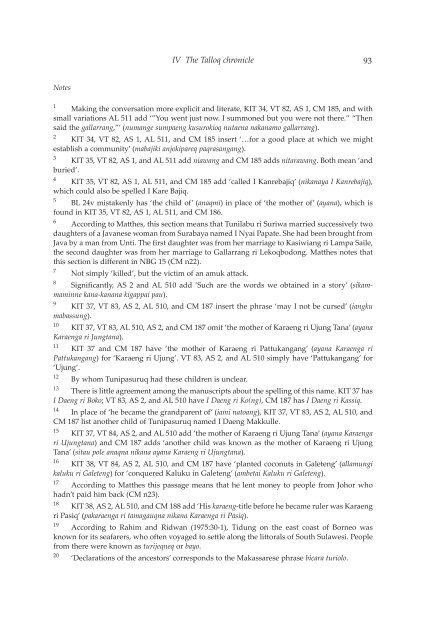A CHAIN OF KINGS - Books and Journals
A CHAIN OF KINGS - Books and Journals
A CHAIN OF KINGS - Books and Journals
You also want an ePaper? Increase the reach of your titles
YUMPU automatically turns print PDFs into web optimized ePapers that Google loves.
Notes<br />
IV The Talloq chronicle 93<br />
1 Making the conversation more explicit <strong>and</strong> literate, KIT 34, VT 82, AS 1, CM 185, <strong>and</strong> with<br />
small variations AL 511 add ‘”You went just now. I summoned but you were not there.” “Then<br />
said the gallarrang,”’ (numange sumpaeng kusurokioq nutaena nakanamo gallarrang).<br />
2 KIT 34, VT 82, AS 1, AL 511, <strong>and</strong> CM 185 insert ‘…for a good place at which we might<br />
establish a community’ (mabajiki anjokipareq paqrasangang).<br />
3 KIT 35, VT 82, AS 1, <strong>and</strong> AL 511 add niawang <strong>and</strong> CM 185 adds nitarawang. Both mean ‘<strong>and</strong><br />
buried’.<br />
4 KIT 35, VT 82, AS 1, AL 511, <strong>and</strong> CM 185 add ‘called I Kanrebajiq’ (nikanaya I Kanrebajiq),<br />
which could also be spelled I Kare Bajiq.<br />
5 BL 24v mistakenly has ‘the child of’ (anaqmi) in place of ‘the mother of’ (ayana), which is<br />
found in KIT 35, VT 82, AS 1, AL 511, <strong>and</strong> CM 186.<br />
6 According to Matthes, this section means that Tunilabu ri Suriwa married successively two<br />
daughters of a Javanese woman from Surabaya named I Nyai Papate. She had been brought from<br />
Java by a man from Unti. The first daughter was from her marriage to Kasiwiang ri Lampa Saile,<br />
the second daughter was from her marriage to Gallarrang ri Lekoqbodong. Matthes notes that<br />
this section is different in NBG 15 (CM n22).<br />
7 Not simply ‘killed’, but the victim of an amuk attack.<br />
8 Significantly, AS 2 <strong>and</strong> AL 510 add ‘Such are the words we obtained in a story’ (sikam-<br />
maminne kana-kanana kigappai pau).<br />
9 KIT 37, VT 83, AS 2, AL 510, <strong>and</strong> CM 187 insert the phrase ‘may I not be cursed’ (iangku<br />
mabassung).<br />
10 KIT 37, VT 83, AL 510, AS 2, <strong>and</strong> CM 187 omit ‘the mother of Karaeng ri Ujung Tana’ (ayana<br />
Karaenga ri Jungtana).<br />
11 KIT 37 <strong>and</strong> CM 187 have ‘the mother of Karaeng ri Pattukangang’ (ayana Karaenga ri<br />
Pattukangang) for ‘Karaeng ri Ujung’. VT 83, AS 2, <strong>and</strong> AL 510 simply have ‘Pattukangang’ for<br />
‘Ujung’.<br />
12 By whom Tunipasuruq had these children is unclear.<br />
13 There is little agreement among the manuscripts about the spelling of this name. KIT 37 has<br />
I Daeng ri Boko; VT 83, AS 2, <strong>and</strong> AL 510 have I Daeng ri Ko(ng), CM 187 has I Daeng ri Kassiq.<br />
14 In place of ‘he became the gr<strong>and</strong>parent of’ (iami natoang), KIT 37, VT 83, AS 2, AL 510, <strong>and</strong><br />
CM 187 list another child of Tunipasuruq named I Daeng Makkulle.<br />
15 KIT 37, VT 84, AS 2, <strong>and</strong> AL 510 add ‘the mother of Karaeng ri Ujung Tana’ (ayana Karaenga<br />
ri Ujungtana) <strong>and</strong> CM 187 adds ‘another child was known as the mother of Karaeng ri Ujung<br />
Tana’ (sitau pole anaqna nikana ayana Karaeng ri Ujungtana).<br />
16 KIT 38, VT 84, AS 2, AL 510, <strong>and</strong> CM 187 have ‘planted coconuts in Galeteng’ (allamungi<br />
kaluku ri Galeteng) for ‘conquered Kaluku in Galeteng’ (ambetai Kaluku ri Galeteng).<br />
17 According to Matthes this passage means that he lent money to people from Johor who<br />
hadn’t paid him back (CM n23).<br />
18 KIT 38, AS 2, AL 510, <strong>and</strong> CM 188 add ‘His karaeng-title before he became ruler was Karaeng<br />
ri Pasiq’ (pakaraenga ri tamagauqna nikana Karaenga ri Pasiq).<br />
19 According to Rahim <strong>and</strong> Ridwan (1975:30-1), Tidung on the east coast of Borneo was<br />
known for its seafarers, who often voyaged to settle along the littorals of South Sulawesi. People<br />
from there were known as turijeqneq or bayo.<br />
20 ‘Declarations of the ancestors’ corresponds to the Makassarese phrase bicara turiolo.









![Am HaSefer [Volk des Buches] - Books and Journals](https://img.yumpu.com/20648352/1/174x260/am-hasefer-volk-des-buches-books-and-journals.jpg?quality=85)







